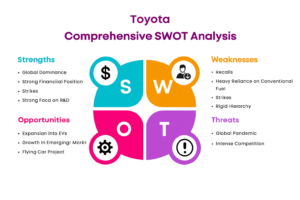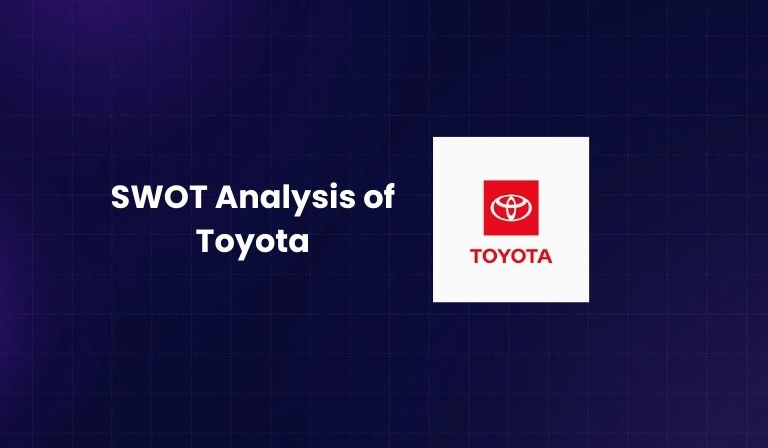Summary
The SWOT Analysis of Toyota highlights why it remains one of the most respected global automotive companies in 2025. Toyota’s strengths include its global dominance, strong financial stability, unmatched brand reputation, hybrid and hydrogen technology leadership, and cutting-edge R&D. Its weaknesses lie in product recalls, dependence on combustion engines, limited emerging market presence, and technology gaps with Tesla. The opportunities for Toyota include growth in electric vehicles, digital transformation, autonomous driving, and expansion into emerging markets. However, threats like economic instability, raw material price hikes, cybersecurity risks, and intense competition challenge its leadership.
This blog will cover Toyota’s SWOT analysis in detail, helping you understand how the company is positioned in today’s fast-changing automotive industry.
Toyota Motor Corporation, founded in 1937, is one of the world’s largest and most influential automotive manufacturers. The brand is known for its reliability, innovation, and commitment to sustainability. Toyota’s vehicles are sold in over 200 countries, and it has consistently been ranked among the top three automakers globally by market share.
Over the years, Toyota has pioneered many innovations: from the Toyota Production System (lean manufacturing), to introducing the Prius, the world’s first mass-produced hybrid car, and now venturing into hydrogen fuel cell vehicles and solid-state batteries.
But like every global company, Toyota faces both internal and external challenges. This detailed SWOT Analysis of Toyota (Updated 2025) breaks down its Strengths, Weaknesses, Opportunities, and Threats.

Also Read: SWOT Analysis of Ducati
Strengths of Toyota
1. Global Dominance
Toyota has a 10.7% global market share and operations in over 200 countries. Its balanced presence across developed markets (like the U.S., Japan, and Europe) and emerging markets (like India and Brazil) provides resilience against regional economic downturns.
- For example, while U.S. sales dipped in 2022, Toyota grew sales in Asia-Pacific markets, balancing its global performance.
- Its dominance ensures bargaining power with suppliers, easier access to markets, and strong consumer recognition worldwide.
2. Strong Financial Position
Toyota reported net income of over ¥5 trillion in 2023, showing its financial strength. With an A+ Fitch rating, Toyota enjoys lower borrowing costs, giving it an advantage over rivals with weaker balance sheets.
- Strong finances allow Toyota to invest heavily in R&D, battery technology, and future mobility projects.
- Unlike competitors who struggled during COVID-19, Toyota remained profitable, proving its resilience.
3. Powerful Brand Equity
Toyota consistently ranks as one of the world’s most valuable automotive brands, with a brand value of $64.5 billion (2024).
- Synonymous with reliability, quality, and affordability, Toyota enjoys customer loyalty across generations.
- Popular models like Corolla (over 50 million sold globally) and Camry reinforce its brand power.
- Its luxury arm Lexus adds premium credibility.
4. High Investment in R&D
In 2023, Toyota invested ¥1.24 trillion in R&D, supported by 15 research facilities across 8 countries.
- Focus areas: next-gen EV batteries, hydrogen fuel cells, AI, autonomous driving, and nanomaterials.
- Toyota’s hybrid technology success came from long-term R&D investments that competitors are now trying to replicate.
- Future readiness is driven by its ambitious Toyota Research Institute (TRI), dedicated to AI and mobility.
5. Hydrogen Fuel Cell Leadership
Toyota leads in hydrogen vehicle innovation, with 5,680 patents in this field. Its Mirai fuel cell car is one of the most advanced hydrogen-powered vehicles globally.
- As governments push for zero-emission vehicles, Toyota’s hydrogen expertise positions it uniquely against rivals focused only on battery EVs.
- Hydrogen could dominate long-haul trucking and heavy vehicles, where batteries have limitations.
6. Extensive Supply Chain & Lean Manufacturing
Toyota’s supply chain and Toyota Production System (TPS) are globally admired.
- By focusing on “Just-in-Time” manufacturing, Toyota reduces waste and improves efficiency.
- Its vast network of suppliers, factories, and dealerships ensures resilience during disruptions.
7. High Production Capacity
Toyota produces nearly 9 million vehicles annually, ranking among the top automakers in volume.
- This allows Toyota to capture economies of scale, negotiate better deals with suppliers, and maintain cost efficiency.
8. Hybrid Technology Leadership
Toyota pioneered hybrid cars with the Prius in 1997 and has sold over 20 million hybrids globally.
- Hybrids act as a bridge between internal combustion engines (ICEs) and EVs, giving Toyota an edge in markets where EV adoption is still slow.
9. Wide Product Portfolio
From affordable cars (Corolla, Yaris) to luxury (Lexus), SUVs (RAV4, Land Cruiser), and green vehicles (Prius, Mirai), Toyota serves all consumer segments.
- This diversification spreads risk and maximizes revenue opportunities.
10. Solid-State Battery Breakthrough
Toyota shocked the industry in 2021 by announcing solid-state batteries capable of 1200 km range and 10-minute charging. This positions Toyota ahead of most competitors in EV battery innovation.
Weaknesses of Toyota
1. Product Recalls
Toyota has faced large-scale recalls, such as the 211,000 cars recalled in 2024 for safety defects. Recalls damage Toyota’s image of reliability and cost billions.
2. Overdependence on Internal Combustion Engines
While Toyota is a hybrid leader, it has been slower in fully electric adoption compared to Tesla and BYD. This conservative approach risks losing ground as markets move rapidly toward EVs.
- Labor Strikes
Strikes in Toyota’s India plant (2023) highlighted tensions between management and labor. Strikes disrupt production, delay deliveries, and hurt sales.
4. Rigid Hierarchy
Toyota’s top-down decision-making culture sometimes slows innovation and responsiveness. In contrast, Tesla and Chinese EV makers are more agile.
5. Weak Emerging Market Presence
While Toyota dominates in developed economies, its presence in Africa, South America, and parts of Asia is limited compared to rivals like Hyundai and Suzuki. This means missed opportunities in high-growth regions.
6. Technology Gap with Tesla
Tesla is 5–6 years ahead in areas like EV software, battery efficiency, and autonomous driving. Toyota’s slower pace in these technologies could hurt competitiveness.
7. High Capital Expenditure
Toyota spends massive amounts on R&D, plants, and compliance. While necessary, it strains finances during downturns.
8. Overextension Risk
Managing such a vast product portfolio and global presence risks inefficiencies, diluted focus, and increased operational complexity.
Opportunities for Toyota
1. Expansion into EVs
Global EV demand is expected to grow 35% annually through 2030. Toyota’s move into EVs with models like bZ4X can capture this growing market.
2. Growth in Emerging Markets
Middle-class growth in India, Brazil, and Africa means millions of new car buyers. Toyota can tailor affordable EVs and hybrids for these markets.
3. Flying Car Project
Toyota invested in SkyDrive, a Japanese flying car startup. While futuristic, it reinforces Toyota’s forward-looking innovation.
4. Smart Cars & Autonomous Driving
Toyota is working on Guardian and Chauffeur AI systems for semi-autonomous driving. With governments allowing more trials, this is a huge growth avenue.
5. Cloud & AI Technology
By integrating AI and cloud services into vehicles, Toyota can offer predictive maintenance, safety features, and digital driving experiences.
6. Sustainable Production
Toyota can cut costs and strengthen its eco-friendly image by adopting green production methods, such as renewable-powered plants.
7. Big Data Utilization
Millions of Toyota vehicles on the road generate driving data. Toyota can use this data for design improvements, safety systems, and customer personalization.
8. Hydrogen & Battery Innovation
Toyota’s dual investment in hydrogen and solid-state batteries gives it multiple paths to win in the future of mobility.
9. Shared Mobility & Ride-Hailing
With car ownership declining in cities, Toyota can expand into mobility-as-a-service (MaaS), competing with Uber and Lyft.
Threats to Toyota
1. Intense Competition
Toyota faces competition from Volkswagen, GM, Ford, Hyundai, BYD, and Tesla. Startups like Rivian and NIO add further pressure.
2. Rising Raw Material Costs
The costs of lithium, cobalt, steel, and aluminum are rising, impacting profitability.
3. Regulatory Changes
Governments are tightening emission and safety standards, requiring more R&D spending.
4. Cybersecurity Risks
As cars become software-driven, Toyota faces threats of hacking and data breaches.
5. Supply Chain Disruptions
Events like the semiconductor shortage (2020–22) exposed vulnerabilities in Toyota’s global supply chain.
6. Changing Consumer Preferences
Consumers increasingly demand eco-friendly, digital-first cars. Failure to keep up risks losing younger customers to Tesla or Chinese EVs.
Conclusion
The SWOT Analysis of Toyota (2025) shows a brand that combines tradition with innovation. Its strengths in brand value, financial stability, hybrids, and hydrogen give it a competitive edge. But weaknesses like slow EV adoption, recalls, and emerging market gaps need urgent attention.
Toyota’s opportunities in EVs, hydrogen, autonomous driving, and sustainability are massive. However, threats like competition, rising costs, and regulatory pressures cannot be ignored.
If Toyota successfully leverages its R&D and adapts to changing consumer needs, it can remain a global leader shaping the future of mobility.
FAQs
Q1. What is Toyota’s biggest strength?
Its brand reputation, hybrid leadership, and financial stability.
Q2. What is Toyota’s biggest weakness?
Its slow EV adoption and product recalls.
Q3. What opportunities does Toyota have?
Expansion into EVs, autonomous driving, hydrogen fuel cells, and emerging markets.
Q4. What are the biggest threats Toyota faces?
Intense competition, rising raw material costs, cybersecurity risks, and regulatory challenges.
Q5. Why is the SWOT Analysis of Toyota important?
It helps investors, analysts, and students understand Toyota’s competitive position and strategic direction in 2025.
A digital marketer with a strong focus on SEO, content creation, and AI tools. Creates helpful, easy-to-understand content that connects with readers and ranks well on search engines. Loves using smart tools to save time, improve content quality, and grow online reach.

